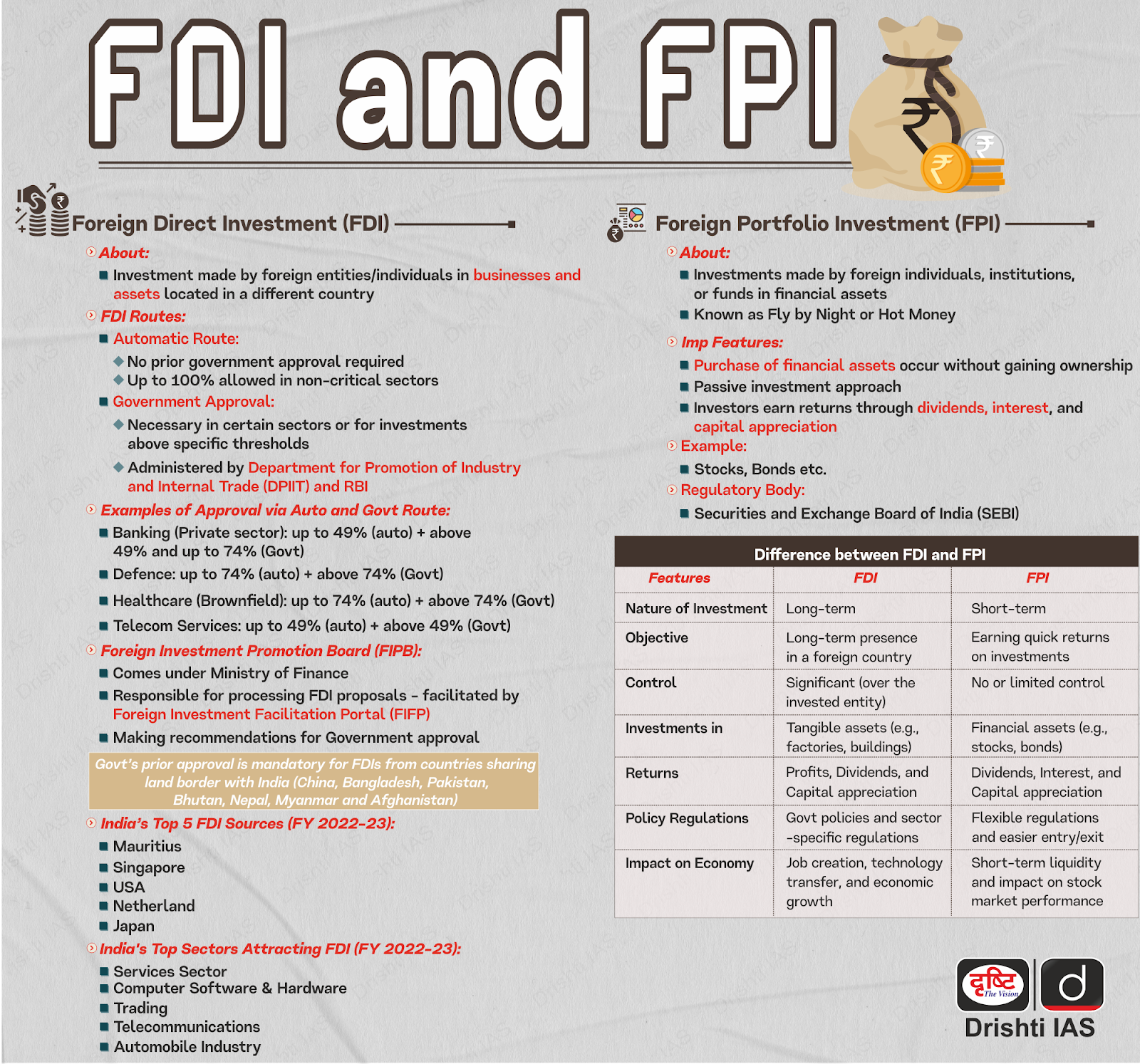Indian Economy
Shifts in Foreign Portfolio Investments In India
- 17 Jan 2024
- 6 min read
For Prelims: Foreign portfolio investments, Double Taxation Avoidance Agreement, Foreign Direct Investment, Assets Under Custody, Capital Market.
For Mains: Difference in FDI and FPI, Risks Associated with FPI.
Why in News?
Foreign portfolio investments (FPIs) into India have witnessed a significant reshuffling in the pecking order among regions.
- This transformation is attributed to various factors, including regulatory changes, geopolitical events, and strategic alliances.
What are the Significant Changes in India’s FPI Landscape?
- Luxembourg's Ascendancy:
- Luxembourg has become the third-largest region for FPIs in India, surpassing Mauritius, with its Assets Under Custody (AUC) growing by 30% to ₹4.85 lakh crore.
- Globally, its equity assets are now second only to the United States.
- The surge is linked to strengthened India-Europe ties, resulting in three financial agreements.
- Luxembourg hosts over 1,400 FPI accounts out of 3,000 in Europe (excluding the UK).
- Collaborations, notably with GIFT City, have further strengthened financial ties between India and Luxembourg.
- Luxembourg has become the third-largest region for FPIs in India, surpassing Mauritius, with its Assets Under Custody (AUC) growing by 30% to ₹4.85 lakh crore.
- France's Notable Gains:
- France has entered the top ten FPIs with a remarkable 74% growth in AUC, reaching ₹1.88 lakh crore.
- This ascent is fueled by the favourable tax provisions under the Double Taxation Avoidance Agreement (DTAA) between India and France.
- Other Players in the Reshuffled Landscape:
- Ireland and Norway have climbed one position each, now ranking 5th and 7th among FPI jurisdictions.
- Ireland's attractiveness stems from its tax efficiencies and global reach, offering regulated funds exemption from Irish tax on income and gains.
- Also, despite a 19% year-on-year growth in AUC, Canada dropped one place in the rankings. The impact of the diplomatic tensions between India and Canada on investments remains uncertain.
- Ireland and Norway have climbed one position each, now ranking 5th and 7th among FPI jurisdictions.
What is Foreign Portfolio Investment?
- About:
- FPI refers to investments made by foreign individuals, corporations, and institutions in the financial assets of India, such as stocks, bonds, and mutual funds.
- These investments are mainly for the purpose of short-term gains and portfolio diversification, unlike Foreign Direct Investment (FDI) which involves long-term ownership of assets.
- FPI refers to investments made by foreign individuals, corporations, and institutions in the financial assets of India, such as stocks, bonds, and mutual funds.
- Benefits:
- Capital Inflow: FPI results in the inflow of foreign capital into the Indian financial markets, which contributes to increased liquidity and capital availability.
- Boost to Stock Market: Increased FPI can positively impact the stock market, leading to higher valuations and increased investor confidence.
- Technology Transfer: FPI often involves investments in technology-oriented sectors, leading to induced technology transfer and advancements in various industries.
- Global Integration: FPI promotes global integration of financial markets, allowing Indian markets to align with global trends and attract foreign investors.
- Risk:
- Market Volatility and Capital Flight: FPI flows can be volatile, driven by global economic and geopolitical factors.
- Sudden inflows or outflows can lead to market instability and currency fluctuations, harming both domestic investors and the economy.
- Transparency and Identification of Beneficial Owners: Identifying the ultimate beneficiaries of complex FPI structures can be challenging for regulators, raising concerns about potential misuse of funds and tax evasion.
- Market Volatility and Capital Flight: FPI flows can be volatile, driven by global economic and geopolitical factors.
- Assets Under Custody: AUC refers to the total value of financial assets that a custodian manages for their clients. It can also refer to the closing market value of all equities held by FPIs.
- Pecking Order: The pecking order in the context of FPIs refers to the ranking or hierarchy of regions or countries from which foreign investors channel their investments into a target country, in this case, India.
UPSC Civil Services Examination, Previous Year Questions (PYQ)
Prelims
Q. Which one of the following groups of items is included in India’s foreign-exchange reserves? (2013)
(a) Foreign-currency assets, Special Drawing Rights (SDRs) and loans from foreign countries
(b) Foreign-currency assets, gold holdings of the RBI and SDRs
(c) Foreign-currency assets, loans from the World Bank and SDRs
(d) Foreign-currency assets, gold holdings of the RBI and loans from the World Bank.
Ans: (b)
Q. With reference to Foreign Direct Investment in India, which one of the following is considered its major characteristic? (2020)
(a) It is the investment through capital instruments essentially in a listed company.
(b) It is a largely non-debt creating capital flow.
(c) It is an investment which involves debt-servicing.
(d) It is the investment made by foreign institutional investors in the Government securities.
Ans: (b)
Mains:
Q. Justify the need for FDI for the development of the Indian economy. Why is there a gap between MoUs signed and actual FDIs? Suggest remedial steps to be taken for increasing actual FDIs in India. (2016)
Q. Foreign Direct Investment in the defence sector is now set to be liberalised. What influence is this expected to have on Indian defence and economy in the short and long run? (2014)







